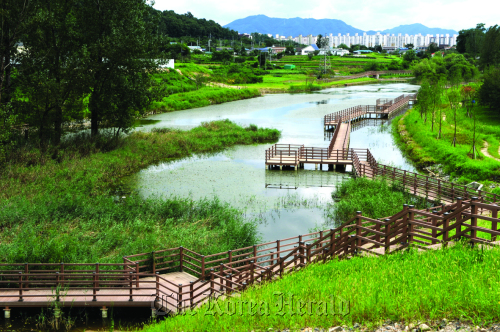
A member of the prestigious French Academy, Erik Orsenna, in his book ‘The Future of Water,’ describes the water crisis caused by climate change in Australia, China, Africa and Southeast Asia to demonstrate the stark reality of the water crises many countries are facing and their struggle to tackle water-related problems.
Water crisis is no longer a story confined to a few faraway countries. The annual average precipitation of Korea is 1,245 millimeters, amounting to 1.4 times the global average (880 millimeters), but only 30 percent of it is actually available for use. The four major rivers of Korea, lifelines for its 50 million population, are very vulnerable to climate change.
The rivers dry up and water quality deteriorates every dry season. In that the precipitation varies widely from season to season and from region to region, some parts of the nation experience water shortages every year. The growing impact of climate change is easily felt. One of the extreme weather events that worries people is the increasing number of days of torrential rain (over 100 millimeters per day) in recent years.
The Four Major Rivers Restoration Project was launched under such circumstances, and it was an inevitable movement of the era. Over two years have passed since the launch of the project, and now it is at its final stage.
Dredging, construction of weirs and most other parts of the project are heading toward completion in accordance with the original plan. Public expectation is high, now more than ever, for the water quality of the rivers and the expected change of the ecosystem.
The Korean government is carrying out multiple projects, such as the construction of a number of sewage treatment facilities and livestock wastewater treatment facilities, to improve the water quality and aquatic ecosystem of the four rivers.
By the completion of these projects in 2012, “quality water” ― with Biochemical Oxygen Demand levels under 3 parts per million ― will account for more than 80 percent of the water in Korea. Furthermore, construction of 16 new weirs will help stabilize water flows, markedly reducing the chronic water quality degradation and pollution-causing accidents during dry seasons.
Although providing the Korean people with safe drinking water has always been the first priority of environmental policies, the government has so far taken measures belatedly after problems occurred. This will not be the case from next year on.
Preemptive water quality monitoring will predict changes in water quality and allow us to take action beforehand. The water quality forecast will run from next January at 16 weirs to predict the water quality of rivers in the same manner we forecast the weather.
The sewage treatment system will be strengthened when the water quality forecast predicts higher water pollution. The dams, weirs and reservoirs will control the water level corresponding to the water quality forecast. This will organically manage both the quantity and quality of water by linking them together.
Water crisis is no longer a story confined to a few faraway countries. The annual average precipitation of Korea is 1,245 millimeters, amounting to 1.4 times the global average (880 millimeters), but only 30 percent of it is actually available for use. The four major rivers of Korea, lifelines for its 50 million population, are very vulnerable to climate change.
The rivers dry up and water quality deteriorates every dry season. In that the precipitation varies widely from season to season and from region to region, some parts of the nation experience water shortages every year. The growing impact of climate change is easily felt. One of the extreme weather events that worries people is the increasing number of days of torrential rain (over 100 millimeters per day) in recent years.
The Four Major Rivers Restoration Project was launched under such circumstances, and it was an inevitable movement of the era. Over two years have passed since the launch of the project, and now it is at its final stage.
Dredging, construction of weirs and most other parts of the project are heading toward completion in accordance with the original plan. Public expectation is high, now more than ever, for the water quality of the rivers and the expected change of the ecosystem.
The Korean government is carrying out multiple projects, such as the construction of a number of sewage treatment facilities and livestock wastewater treatment facilities, to improve the water quality and aquatic ecosystem of the four rivers.
By the completion of these projects in 2012, “quality water” ― with Biochemical Oxygen Demand levels under 3 parts per million ― will account for more than 80 percent of the water in Korea. Furthermore, construction of 16 new weirs will help stabilize water flows, markedly reducing the chronic water quality degradation and pollution-causing accidents during dry seasons.
Although providing the Korean people with safe drinking water has always been the first priority of environmental policies, the government has so far taken measures belatedly after problems occurred. This will not be the case from next year on.
Preemptive water quality monitoring will predict changes in water quality and allow us to take action beforehand. The water quality forecast will run from next January at 16 weirs to predict the water quality of rivers in the same manner we forecast the weather.
The sewage treatment system will be strengthened when the water quality forecast predicts higher water pollution. The dams, weirs and reservoirs will control the water level corresponding to the water quality forecast. This will organically manage both the quantity and quality of water by linking them together.

The Four Major Rivers Restoration Project will secure abundant clean water, resulting in healthy and diverse aquatic ecosystems. Endangered species including the Miho spine loach (Iksookimia Choii) and the Korean stumpy bullhead (Pseudo bagrus brevicorpus) have been successfully recovered; indigenous fish such as the Nakdong gudgeon (Gobiobotia naktongensis), the black shiner (Pseudopungtungia nigra) and the bull-head torrent catfish (Liobagrus Obesus) are now bred.
A total of twelve species will be recovered and released in inhabitable rivers by 2012. Furthermore, 179 new wetlands will provide habitats for aquatic organisms.
Monitoring will be strengthened to verify the revitalization of ecosystem. Changes in the water quality and aquatic creatures before and after the construction of weirs will be observed. Based on the findings, the aquatic ecosystem will be mapped, and then a monitoring network will be established to examine the health of aquatic creatures.
Scientific examinations are also planned to gather data that would illustrate the scientific achievements of the Four Major Rivers Restoration Project.
The clean, abundant water is expected to bring about changes not only in the aquatic ecosystem but also the life of human beings. We can easily visualize people young and old from all walks of life riding bicycles along the restored river, enjoying the fresh air and beautiful scenery of the water front.
Children will frequently spot and learn about diverse fish and aquatic plants, getting familiar with nature. Various water sports and water-based leisure activities will gain popularity.
The attitude of people toward water matters, too. While fully enjoying the gifts from water, we should conserve water and the surrounding environment. Then the rivers will bring us back even greater benefit.
The Four Major Rivers Restoration Project benefits us economically. The experience and technologies gained throughout the project will help Korea enter the markets of Southeast Asia, Africa and other emerging countries where water industries are growing exponentially.
Last May, the Ministry of Environment of Korea and Indonesia signed a Memorandum of Understanding worth 1 trillion won for the recovery of the ecosystem of an urban river in Jakarta.
Water, dubbed the “blue gold” of 21st century, is in the global limelight. The Four Major Rivers Restoration Project has enhanced the water management capacity of Korea. Thanks to this experience, Korea is expected to dominate the global water industry, which will be worth over 1,000 trillion won, and lead the era of “blue gold.”
As described above, the Four Major Rivers Restoration Project promises us a better future. It will prepare us to cope with climate change, secure plentiful clean water resources and upgrade the quality of our lives.
As the four great ancient civilizations emerged along rivers, the restored four major rivers in Korea will be the main driving force behind the nation. Clean, abundant rivers and the aquatic ecosystem will enrich human life.
The Four Major Rivers Restoration Project will enable us to pass on a beautiful ecology and a future of sustainable development to the next generation.
By Yoo Young-sook, Minister of Environment


![[AtoZ into Korean mind] Humor in Korea: Navigating the line between what's funny and not](http://res.heraldm.com/phpwas/restmb_idxmake.php?idx=644&simg=/content/image/2024/04/22/20240422050642_0.jpg&u=)


![[Herald Interview] Why Toss invited hackers to penetrate its system](http://res.heraldm.com/phpwas/restmb_idxmake.php?idx=644&simg=/content/image/2024/04/22/20240422050569_0.jpg&u=20240422150649)
![[Graphic News] 77% of young Koreans still financially dependent](http://res.heraldm.com/phpwas/restmb_idxmake.php?idx=644&simg=/content/image/2024/04/22/20240422050762_0.gif&u=)
![[Exclusive] Korean military set to ban iPhones over 'security' concerns](http://res.heraldm.com/phpwas/restmb_idxmake.php?idx=644&simg=/content/image/2024/04/23/20240423050599_0.jpg&u=20240423183955)






![[Exclusive] Korean military to ban iPhones over security issues](http://res.heraldm.com/phpwas/restmb_idxmake.php?idx=652&simg=/content/image/2024/04/23/20240423050599_0.jpg&u=20240423183955)



![[Today’s K-pop] Ateez confirms US tour details](http://res.heraldm.com/phpwas/restmb_idxmake.php?idx=642&simg=/content/image/2024/04/23/20240423050700_0.jpg&u=)